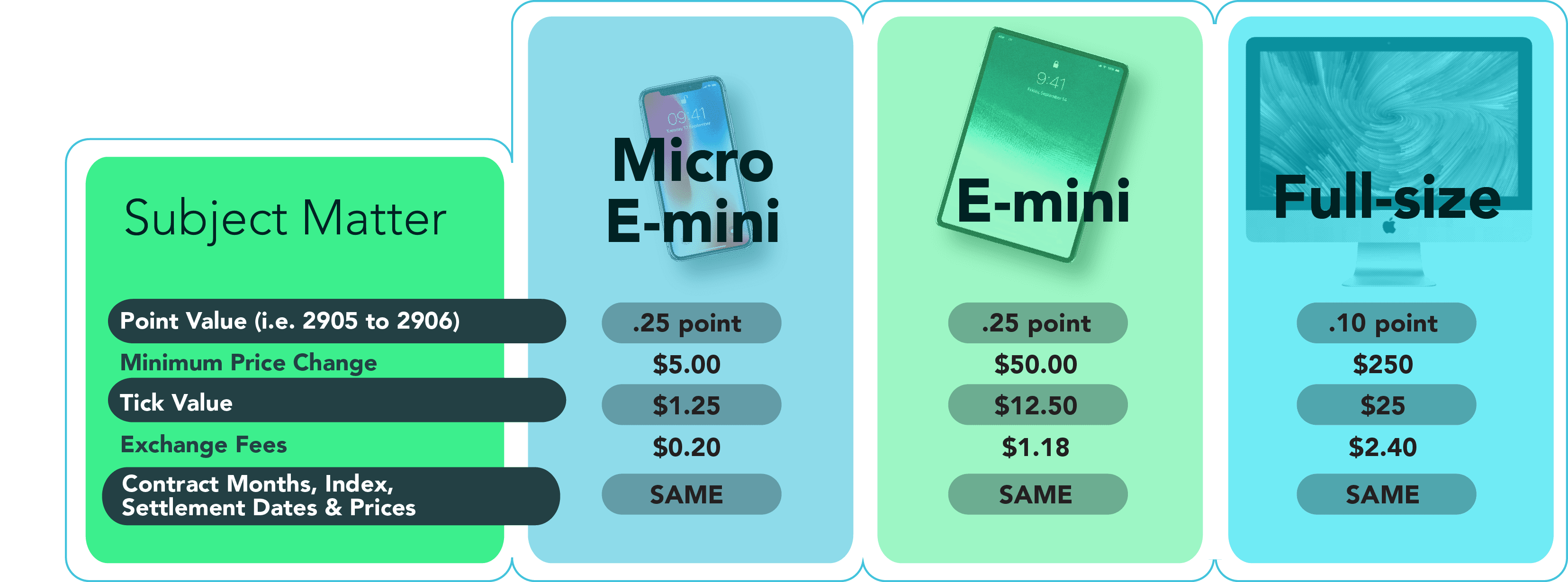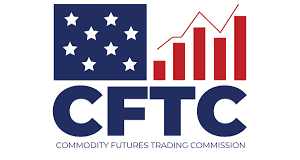
What are Micro E-Mini Futures?
The CME Group launched micro e-mini contracts for four major indices on May 6, 2019. These contracts allow market participants to gain exposure to price fluctuations in the S&P 500, Russell 2000, Dow Jones 30 and Nasdaq100 indices at a much lower cost than the existing e-mini futures. Depending on which broker you use, you can go long or short markets like the S&P500 and Nasdaq100 with as little as $175 of day-trading margin per contract, offering an effective way to hedge your overall portfolio for futures trading.
Right out of the gate, these contracts proved extremely popular. The micro e-mini S&P 500 futures hit a volume of almost 417,000 contracts traded on June 3, 2019, though it’s cooled off a bit since then. These micro contract volumes are approximately 25 percent of the volume of their much more established e-mini cousins. The contracts trade from Sunday 5 PM central time through Friday 4 PM central time for almost 24 hours a day in the same way as futures trading.
How Do Micro E-Mini Futures Work?
E-minis were launched in the late 1990s when the values of the major indices got too large for the average trader. Index Futures are futures contracts that allow investors to buy or sell a financial index today to be settled at a date in the futures trading. The micro e-mini contracts are 1/10 the size of previous e-mini contracts, reducing the cost of the trade to 1/10th the cost of e-minis.
The S&P 500 and Russell 2000 e-minis are priced at $50 times the value of the index when the contract expires while the micro e-mini for those two are just $5 times the value. The micro e-mini contract for the Nasdaq 100 index is $2 times the index value, and the Dow Jones 30 micro e-mini is $0.50 times the index value. So, if the S&P 500 index is 2950, the micro e-mini value is $14,750 versus the e-mini which would be priced at $147,500.
The micro e-mini S&P 500 index futures are designed to manage exposure to the 500 U.S. large-cap stocks tracked by the S&P 500 index. The micro e-mini Russell 200 index futures offer exposure to the 2,000 small-cap stocks in the Russell 3000 universe of stocks. You’ll get exposure to the 30 blue chip stocks in the Dow Jones Industrial Average with the micro e-mini Dow Jones Industrial Average futures, and to the 100 leading non-financial U.S. large-cap stocks in the Nasdaq 100 with the micro e-mini Nasdaq 100 futures trading.
Micro E-mini futures will be listed on the customary U.S. Equity Index futures cycle with five concurrent futures that expire against the opening index value on the third Friday of March, June, September, and December, except for the Dow micro e-mini future, which will list four months. The CME has not yet announced whether they will enable options on the micro e-mini futures trading.
What are Micro E-mini Stock Index Futures In Deeper Detail?
The micro e-mini futures are a smaller version of the standard E-mini index derivatives for the following U.S. stock indices: S&P 500, Dow Jones Industrial Average, Nasdaq 100, and Russell 2000.
The futures contract for each market gives the trader leveraged exposure to the underlying “cash” stock index to which the futures are correlated. In short, these derivatives are like trading a miniaturized version an entire index in one contract for the ones who were searching for e mini-S&P.
These are “cash-settled” instruments. So, if you allow your contract to expire, say, for a purchased (or “long”) position, what you receive for delivery are not shares of stock but its cash equivalence based on its market value at the time of expiration for e mini-S&P.
Contract Specifications
As with all futures contracts, each of the four micro E-mini contracts have their own unique identification symbols:
• Micro E-mini S&P 500 – listed as MES
• Micro E-mini Dow Jones – listed as MYM
• Micro E-mini Nasdaq 100 – listed as MNQ
• Micro E-mini Russell 2000 – M2K
So, how small are these contracts and how much do they move dollar-wise per tick?
Well, the value of each MES contract is $5 times the S&P 500 index; MYM, $0.50 times the DJIA index; MNQ, $2 times the Nasdaq 100; and M2K, $5 times the Russell 2000.
When it comes to the dollar value per tick (minimum price fluctuations), at these levels, the MES moves $1.25 per tick (per contract); and the MYM, MNQ, and M2K all move $0.50 per tick (per contract).
Compared with the standard e-minis, which move, respectively, $12.50 and $5.00 per tick, the micros are relatively small, at a tenth of the value. And this is where these unique contracts may give you an advantage over their larger counterpart of e mini-S&P.
The Benefits of Micro E-Mini Futures Trading
Potential Testing Advantages on E mini-S&P
Have you ever been in a position where you wanted to test a new method or system but hesitated because you didn’t want to risk losing money if it failed? Instead, you probably tested your method in a paper trading environment for e mini-S&P. And that might have been a mistake.
Chances are that you probably fine-tuned your method or system (perhaps for months) in a simulated environment only to find out that it doesn’t work in a live trading environment. If you’ve traded long enough, then it is likely you have experienced this frustrating loop in e mini-S&P.
What you probably needed was a testing ground situated between a too-big-a-risk environment and a no-risk simulation.
And that’s exactly what a micro-E-mini futures contract provides–an in-between space where you can test a method in a live market but with a risk that is only a tenth of the size of a standard contract, potentially small enough to be manageable.
Potential Scaling Advantages
Have you ever wanted to trade those larger price movements but couldn’t afford the deep stop losses that such scenarios sometimes require? Or have you ever wanted to scale your positions, making them larger or smaller to add or reduce risk?
With a tenth of the exposure for Auto Trading, micro contracts might allow you to trade larger price swings. And if you view each contract as a smaller “chunk” of a larger position, you might also be able to better manage your positions by adding or reducing the number of contracts you hold.
Potential Margin Advantages for Auto Trading
Perhaps you’re tired of having to take ultra short-term trades, closing your positions before the end of the market day simply because the full “overnight” margins are prohibitively high. Perhaps you want to place swing trades or position trades requiring you to hold your futures contracts for several days to weeks in Auto Trading.
Micro E-mini margins feature much lower margins that might finally allow you to do just that for Auto Trading.
- Micro E-mini S&P 500 contracts can have day trading margins as low as $200 and full margins as low as $630 per contract.
- Micro E-mini DJIA contracts can have day trading margins as low as $200 and full margins as low as $649 per contract.
- Micro E-mini Nasdaq 100 contracts can have day trading margins as low as $200 and full margins as low as $836 per contract.
- Micro E-mini Russell 2000 contracts can have day trading margins as low as $200 and full margins as low as $339 per contract.
These margins are half the day trading margins and roughly a tenth of the full “initial” margins of the standard micro e mini futures contracts for . This means that you may be able to hold a larger number of contracts–to build up or scale down larger positions–or to swing or position trade at relatively lower margin rates.
Potential Benefits of Trading a Real vs “Bucketed” Market.
Every heard of the term “bucket shop”? If not, it’s a kind of investment scheme, illegal in the U.S. for most asset classes (most, not all) but legal in other countries and with varying degrees of regulation in micro e mini futures.
Here’s how it goes: you want to trade the standard E-mini S&P 500 futures, but either you don’t have enough money to cover the margin, or the risk of such a big contract is too big for your account. You want to trade a smaller size lot, similar to the new micro contracts.
So, you purchase these “lots” over the counter (OTC) in the form of CFDs, or “Contracts for Difference.” Here is a simple description of how the process works:
• You purchase a tenth of a contract of the the E-mini S&P 500.
• The LP (or liquidity provider) “sells” you a tenth of the contract–he actually sells you nothing but a “promissory note” for the difference between the buying and selling price.
• If you take a loss and close your position, the LP takes money from your account.
• If your position is profitable and you close it, then the LP owes you money, so hopefully the LP “hedged” the position through owning futures contracts that can offset the LP’s loss for E Mini S&P trading secret.
As you can see, you virtually own nothing but a promissory contract. The LP is the party who may or may not own a futures contract as a hedge. The LP “bucketed” your position, with a promise to pay you if your position makes money or to debit your account if you lose money for Auto Trading.
There are two problems with this scenario: First, if the LP is the third-party offering you these “contracts” for difference, how do you know that the price being offered is not being manipulated to the LP’s unfair advantage? You aren’t buying CFDs from a “market,” you are buying it from a third-party over the counter. The LP exercises control over the entire transactional process for S&P e mini future.
Second, suppose you and other traders with the same (or a similar) position make a massive windfall profit. If the LP didn’t hedge their positions, they run the risk of insolvency in S&P e mini future. And if regulatory governance doesn’t require the LP to pay back 100% of your account equity during their bankruptcy proceeding, then you’re out of luck for S&P e mini future. You can lose a lot more than your profits–you might lose your entire account in S&P e mini future.
Fortunately, micro e-mini futures are traded through a regulated exchange. So not only are prices market-driven and transparent, preventing the risk of price manipulation, the clearing firms and exchanges are also required to hold emergency funds to help prevent counterparty risk should a buyer or seller default on a payment for S&P e mini future.
The Potential Benefits of Micro E-Mini Equity Index Futures in a Nutshell for Index trading
1.Smaller contract exposure allows you to test your trades in a live market without having to risk the full “standard” E-mini amount in Index Trading.
2. Smaller contract exposure also allows you to trade a live market in place of a simulated paper trading environment that may be further from reality than you think.
3. Smaller contract exposures have a lower dollar-per-tick value, which means you might be able to trade larger price movements simply because the risk of deeper stop losses may be reduced by a tenth of the size for Index Trading.
4. Smaller margins allow you to hold positions beyond market close at a more affordable rate–meaning you can now swing trade or position trade, holding positions “overnight” at a much more affordable rate of margin in Index Trading.
5. And finally, smaller contract sizes can allow you to trade a contract in a regulated exchange where price is market-driven and transparent, and where counterparty risk may be tremendously reduced. In short, you can avoid trading with an over-the-counter “bucket shop,” such as the case with CFDs.
These are just a few advantages that micro-E-mini equity Index Trading can provide–advantages that may not be present in the larger standard contracts.
If you need to test a method in a reduced-risk environment, if you would like to trade larger or longer-term price swings in E Mini S&P trading secret, or if your method requires an involved scaling strategy, then you might want to consider trading micro-E-mini futures.
Remember, micro-E-mini futures are unique contracts that can also be utilized as unique tools to help achieve your overall trading goals. And as we said at the top of this article, the tools are secondary to how you use them. So, if you are going to use them, be smart about it and use them well for E Mini S&P trading secrets.















